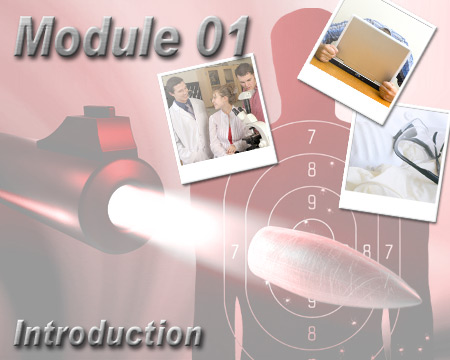Home | Glossary | Resources | Help | Contact Us | Course Map
Archival Notice
This is an archive page that is no longer being updated. It may contain outdated information and links may no longer function as originally intended.
| Author: Kathleen A. Savage |
|
Kathleen Savage holds a Ph.D. from the University of Florida and an MSc from the University of Strathclyde, Scotland. She assisted in the development and teaching of certificate and Masters courses for the University of Florida's forensic science program. A staff member of the National Forensic Science Technology Center (NFSTC) since 2002, Dr. Savage currently serves as the organizations training program manager. |
| Author: Greg Freed |
| Gregory A. Freed, Department of Biological Science, Florida State University. BS - Biological Science, Florida State University. MS (Candidate) - Educational Technology, Boise State University. |
Introduction
Welcome to the Firearm Examiner Training Program. Designed as a training tool for use in conjunction with traditional hands-on mentoring, this program provides the knowledge component for training new examiners. It may also be used as a continuing education tool for current firearm examiners.
The purpose of this module is to explain how this program may be used and to clarify trainer and trainee roles and expectations. Information is provided regarding the use, benefits, and limitations of e-Learning.
Objectives
At the conclusion of this module, the student should be able to do the following:
- Describe how the Firearm Examiner Training Program may be used to train a new firearm examiner.
- Describe the role of the trainer in the process.
- Describe the role of the trainee in the process.
- Explain what e-Learning is and how it is used.
- List the benefits and limitations of e-Learning.
- List the strategies that can be used for successful e-Learning outcomes.
AFTE Knowledge and Ability Factors
| The following table lists the AFTE Knowledge and Ability Factors required to complete this module. | |
| 16. | Knowledge of the proper mechanics of the English language (grammar, punctuation, spelling, and composition) |
| 129. | Knowledge of correct word usage and pronunciation |
| 13. | Ability to use scientific methodology, statistics, and logic in solving forensic problems |
| 19. | Ability to understand and interpret technical data output from laboratory instruments |
| 20. | Ability to make detailed calculations accurately |
| 88. | Ability to read and understand information and ideas presented in writing |
Using the Training Program
Blended training
This training program presents the knowledge component required for new firearm examiners. It complements the existing Training Manual and Procedural Manual developed by the Association of Firearm and Tool Mark Examiners (AFTE). These manuals are available from AFTE upon request.
Click here to visit the AFTE website
Training firearm examiners using a blended approach of technology-based training together with traditional methods of on-the-job mentoring has several advantages, including:
- self-paced modular units of instruction enabling scheduling flexibility,
- increased time available for hands on practical training,
- increased case production,
- reduced time from training inception to casework production,
- consistent quality of training,
- documentation and tracking of training.
Additional Online Courses
- What Every First Responding Officer Should Know About DNA Evidence
- Collecting DNA Evidence at Property Crime Scenes
- DNA – A Prosecutor’s Practice Notebook
- Crime Scene and DNA Basics
- Laboratory Safety Programs
- DNA Amplification
- Population Genetics and Statistics
- Non-STR DNA Markers: SNPs, Y-STRs, LCN and mtDNA
- Firearms Examiner Training
- Forensic DNA Education for Law Enforcement Decisionmakers
- What Every Investigator and Evidence Technician Should Know About DNA Evidence
- Principles of Forensic DNA for Officers of the Court
- Law 101: Legal Guide for the Forensic Expert
- Laboratory Orientation and Testing of Body Fluids and Tissues
- DNA Extraction and Quantitation
- STR Data Analysis and Interpretation
- Communication Skills, Report Writing, and Courtroom Testimony
- Español for Law Enforcement
- Amplified DNA Product Separation for Forensic Analysts




